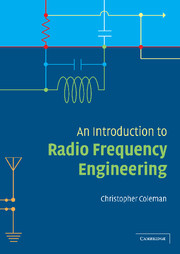Book contents
- Frontmatter
- Contents
- List of figures
- Preface
- Acknowledgements
- 1 Basic concepts
- 2 Frequency selective circuits and matching
- 3 Active devices and amplifiers
- 4 Mixers, modulators and demodulators
- 5 Oscillators and phase locked loops
- 6 Transmission lines and scattering matrices
- 7 Power amplifiers
- 8 Filters
- 9 Electromagnetic waves
- 10 Antennas
- 11 Propagation
- 12 Digital techniques in radio
- Index
3 - Active devices and amplifiers
Published online by Cambridge University Press: 05 June 2012
- Frontmatter
- Contents
- List of figures
- Preface
- Acknowledgements
- 1 Basic concepts
- 2 Frequency selective circuits and matching
- 3 Active devices and amplifiers
- 4 Mixers, modulators and demodulators
- 5 Oscillators and phase locked loops
- 6 Transmission lines and scattering matrices
- 7 Power amplifiers
- 8 Filters
- 9 Electromagnetic waves
- 10 Antennas
- 11 Propagation
- 12 Digital techniques in radio
- Index
Summary
Active devices are important elements in RF systems where they perform functions such as amplification, mixing and rectification. For mixing and rectification, the non-linear properties of the device are of paramount importance. In the case of amplification, however, the non-linear properties can have a damaging effect upon performance. This chapter concentrates on small signal amplifiers for which it is possible to select conditions such that there is, effectively, linear amplification. Amplifiers based on both bipolar junction and field effect transistors are considered and the chapter includes some revision concerning their characteristics and biasing. The high frequency performance of transistor amplifiers is limited by what is known as the Miller effect and a large part of the chapter is devoted to techniques for overcoming this phenomenon.
The semiconductor diode
The semiconductor diode is a device that allows a current flow, but for which the magnitude of the flow depends in a non-linear fashion upon the applied voltage. Many varieties of diode are manufactured by forming junctions out of p- and n-type semiconductors. There are, however, several important diode varieties that have other types of junction (the semiconductor to metal junction of a Schottky diode for example). A p-type semiconductor can be formed by introducing a small amount of indium into silicon. This creates a structure that allows electrons to flow at energy levels slightly above those of the bound electrons. An n-type semiconductor can be formed by introducing a small amount of arsenic into the silicon.
- Type
- Chapter
- Information
- An Introduction to Radio Frequency Engineering , pp. 49 - 85Publisher: Cambridge University PressPrint publication year: 2004



